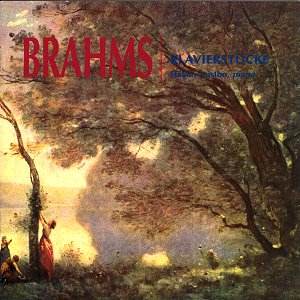The shorter Brahms piano works are more inward looking
than the vivid romanticism of his contemporary, Schumann. Although Brahms
was a brilliant pianist the grandiose gestures favoured by the 19th
century virtuoso piano school put in few appearances in these works.
Indeed, for all their lyrical beauty it would not be inappropriate to
call these pieces ‘pure music’. Brahms did not favour imaginative titles,
and the distinctions between Ballades, Fantasies, Rhapsodies, Intermezzi
etc., refer more to their expressive nature than to strictly musical
forms. From youth to maturity Brahms returned again and again to the
keyboard to provide us with over two and a half hours of entrancing
music. This is music that shows him in a more intimate light than do
the sonatas, piano concertos and variations. The groupings are mainly
chronological and serve to indicate an increasing development in style
and scope.
The warm, clearly focused piano sound in this set is
immediately likeable. It would be difficult to find a more sympathetic
and intelligent interpreter than Håkon Austbø. After the
salon atmosphere of the Ballades the two extrovert Rhapsodies come like
a breath of fresh air. The Op. 76 piano pieces are mostly song-like,
but with no ‘folksy’ connotations. Two are marked Grazioso, though
the markings throughout suggest the composer’s preference for fairly
lively tempi, which Austbø meticulously observes.
Though not fundamentally different in style from the
earlier works, the later Opp, 116, 117, 118 and. 119 pieces show a bolder,
more individual use of piano sonorities and greater harmonic freedom.
Maybe in these relatively small forms Brahms was playfully experimenting
with new ideas. The energetic D minor and G minor Capriccios in Op.
116 (classified as Fantasies) leave the listener unprepared for the
eerie harmonies of the Intermezzi in E minor and E major. All four of
the Op. 119 pieces show Brahms at his most beguiling. Wistful melodies
provide a further opportunity for admiring Austbø’s impressive
pianissimo, leading to the cheerful swagger of the E flat Rhapsody.
Altogether this is a most satisfying set, nicely recorded, beautifully
played and highly recommended to anyone who may yet think of Brahms
as an old, bearded German symphonist.
Roy Brewer
